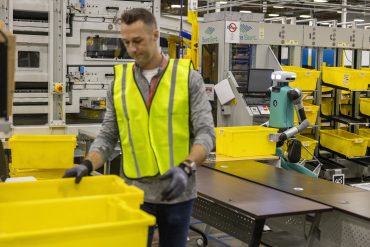

Amazon’s warehouse robots drive record productivity gains as package processing soars to 3,870 units per employee
Key Takeaways
- Amazon deploys over 1 million robots globally approaching the scale of its 1.56 million human workforce, marking the first time robots may equal human workers in warehouse operations.
- Potential savings of $4.5-$10 billion annually by 2030 if 30-40% of U.S. orders are processed through next-generation robotic fulfillment centers, according to Morgan Stanley estimates.
- Productivity surge from 175 to 3,870 packages per employee between 2015 and 2024, while average warehouse staffing drops to 670 employees per facility, the lowest in 16 years.
Introduction
Amazon reaches a historic milestone as its robot workforce approaches parity with human employees for the first time in company history. The e-commerce giant now operates over 1 million robots globally across its warehouse network, representing a fivefold increase since 2020.
This transformation positions Amazon at the forefront of warehouse automation technology, fundamentally altering how the world’s largest online retailer fulfills customer orders. The shift carries significant implications for the broader logistics industry and labor markets nationwide.
Key Developments
Amazon’s robotic fleet encompasses sophisticated systems spanning the entire fulfillment process. The company has introduced six major warehouse robots over the past three years, including Hercules units capable of lifting 1,250 pounds and Proteus autonomous mobile robots that navigate warehouses independently.
The flagship Shreveport, Louisiana fulfillment center exemplifies this technological evolution. Opened in September 2024, the facility processes products 25% faster while reducing fulfillment costs by 25% compared to traditional warehouses.
Amazon’s newest innovation, the Vulcan robot, demonstrates advanced product selection capabilities across multiple shelves. These systems now assist in approximately 75% of the company’s global deliveries, supported by AI-powered inventory optimization and demand forecasting.
Market Impact
The automation push directly addresses Amazon’s substantial operational costs, with labor comprising roughly 60% of fulfillment expenses. The company maintains average warehouse staffing at 670 employees per facility, representing the lowest headcount in 16 years.
Amazon’s $25 billion planned investment in robotics and AI reflects intensifying competition from global e-commerce platforms like Temu. The automation strategy enables expanded same-day delivery to over 4,000 communities, including previously underserved rural areas.
Productivity metrics illustrate the transformation’s scale, with packages shipped per employee climbing from 175 in 2015 to approximately 3,870 in 2024. This efficiency gain positions Amazon advantageously against competitors while supporting its free cash flow generation.
Strategic Insights
Morgan Stanley analysts project Amazon could achieve annual savings of $3 billion for every 10% of U.S. retail units processed through robotic fulfillment centers. If deployment reaches 30-40% of orders by 2030, savings could total $4.5-$10 billion annually.
The strategy addresses chronic warehouse staff turnover while establishing new operational benchmarks for the logistics sector. Amazon’s approach creates a template for competitors seeking similar efficiency gains through automation technology.
However, the transformation raises questions about blue-collar employment sustainability. While Amazon has retrained 700,000 workers since 2019 for robotics-related roles, the company acknowledges its workforce will shrink as AI adoption accelerates.
Expert Opinions and Data
CEO Andy Jassy frames the transition as evolution rather than elimination. “Like with every technical transformation, there will be fewer people doing some of the jobs that the technology actually starts to automate. But there’s going to be other jobs,” he told CNBC.
Amazon Robotics VP Scott Dresser emphasizes workforce development opportunities. The company has upskilled more than 700,000 employees through training programs in robotics, engineering, and maintenance since 2019.
A company spokesperson stated, “These shifts, supported by new automation and AI systems, help us get closer to customers, create jobs in new communities, and improve the experience for both employees and shoppers.” The Wall Street Journal reports that advanced systems like DeepFleet foundation models have improved robot fleet efficiency by 10% while reducing warehouse congestion.
Despite retraining initiatives, Amazon has eliminated more than 27,000 positions since early 2022, with recent cuts affecting retail and devices divisions. Worker advocates express concern about the broader impact on employment in regions dependent on warehouse jobs.
Conclusion
Amazon’s automation milestone establishes new productivity standards across the logistics industry while generating substantial cost savings. The company’s robot-to-human workforce ratio signals a fundamental shift in warehouse operations that competitors will likely emulate.
As the second-largest private employer in the United States and fourth most valuable company globally with over $2.3 trillion market capitalization, Amazon’s automation strategy carries implications extending far beyond its own operations. The approach balances technological advancement with workforce adaptation, though long-term employment effects remain a subject of ongoing debate.








